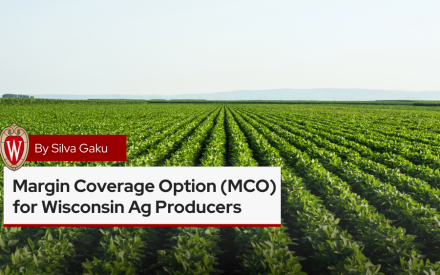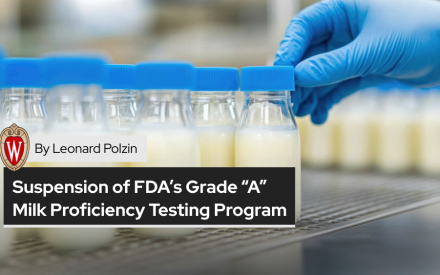Improving energy efficiency and generating renewable energy on the farm can significantly reduce energy expenses over the long term. Thanks to new and expanded funding, agricultural producers can now significantly reduce the upfront cost for clean energy projects on their farms. This article introduces three programs to fund renewable energy systems (RES) and energy efficiency improvements (EEI):
- Rural Energy for America Program (REAP)
- Focus on Energy
- Property Assessed Clean Energy (PACE)
These three programs are complementary and producers may stack them to fully fund RES and EEI projects through grants, rebates, other incentives, and low-cost, long-term financing.
Projects covered by these programs include RES like solar, battery storage, biofuels, and wind power, or EEI projects like efficient lighting systems, building controls, heat pumps, ventilation, and much more. See table below for examples of each project type.
Programs mentioned in this article fund both Renewable Energy Systems (RES) and Energy Efficiency Improvements (EEI). This table shows examples of projects included under each category as listed by the REAP program. This list is not exhaustive of all RES or EEI projects that qualify for this funding.
Program funding can be stacked to cover the full project cost, as shown in this graphic. In this hypothetical example, a REAP grant covers 50% of the cost, Focus on Energy covers 15%, and a PACE loan covers the remaining 35%, accounting for 100% of the project costs.
Rural Energy For America Program (REAP)
REAP is a USDA grant and loan financing program for agricultural producers and local small businesses to install RES and EEI in rural areas. Because it is awarded as a grant, the amount received by the producer does not have to be paid back.
Applicants can cover up to 50% of eligible project costs with REAP grants, with an expansion of funding through the Inflation Reduction Act. This doubles previous funding allocations from the Farm Bill. While applicants must match the federal grant funds awarded, producers can request up to $1 million for RES grants and up to $500,000 for EEI grants. (REAP also offers additional loan financing that can be requested to cover up to 75% of the total project cost, though this loan financing is not covered in this article.)
Two types of businesses are eligible: 1). agricultural producers (entities with at least 50% of their income coming from agricultural production), and 2). rural small businesses (entities with less than 50% of income coming from agricultural production). Agricultural producers anywhere in the state can qualify, while rural small businesses have to be located within designated program areas to qualify.
For additional information, please see the Rural Energy for America Program Renewable Energy Systems & Energy Efficiency Improvement Loans & Grants in Wisconsin webpage.
Wisconsin program contact:
Brenda Heinin, Rural Energy Coordinator
715-619-3123
Focus on Energy
Focus on Energy is a Wisconsin public benefits program for customers of participating electric or gas utilities that offers businesses, homeowners, and renters rebates and incentives for a variety of energy-saving and renewable energy projects and products. In 2022, Focus on Energy awarded more than $2 million in incentives to 880 agribusinesses to improve their facilities’ energy efficiency. In all, these projects totaled more than $3.5 million in annual energy savings on their utility bills.
Qualifying RES and EEI equipment with approved dollar amounts are posted annually on Focus’s website. Because Focus is designed as a rebate program, producers are responsible for paying costs up front and can apply for reimbursement within 60 days after installation. We noted earlier in the article that REAP grants require matching funds, and Focus funding can be used to meet that match. Producers intending to use Focus funds to match federal funds can secure a pre-approval to meet REAP program requirements.
It is worth noting that the budget to fund Focus on Energy rebates and incentives is allocated annually. Thus, it is possible that funding can run out in any given funding cycle. For this reason, producers may want to consider securing pre-approval from Focus on Energy for funding a project in order to be certain about the availability of funds. If funding is not available, applicants can re-apply in the next funding cycle.
Focus on Energy does consider custom applications for RES and EEI equipment that are not included in their catalog. To explore this option or the Focus on Energy program more broadly, producers are encouraged to contact their area Energy Advisor. To find out if your utility participates in the Focus on Energy program, check out the list of Participating Utilities.
Property Assessed Clean Energy (PACE Wisconsin)
PACE is a national model for low-cost, long-term loan programs coordinated by local governments that can help some commercial property owners finance RES and EEI projects as well as water conservation improvements. PACE combines with REAP and Focus on Energy by providing financing for the remainder of a project, after applying those program funds.
PACE loans are available for 5 to 30 year terms, with an interest rate of ~5.0 – 7.0%, calculated based on an indexed interest rate. Loans can be requested within the range of $100,000 to $50 million, and your mortgage lender must consent to PACE financing. PACE loan repayment is typically less than the business’ savings on their utility bills
It is important to note that PACE is not currently available in every Wisconsin county. See this map for participating counties. If you are located in a county that is not currently participating in PACE, please reference this webpage for information on how your community can elect to participate.
See the PACE information for property owners for more information on how to acquire this financing.
| Program | Qualified Entities | Type of Incentive | Funding Available |
|---|---|---|---|
| REAP | Agricultural producers in Wisconsin; and Rural small businesses located in eligible rural areas | Grant | Up to $1 million for RES grants and up to $500,000 for EEI grants Limited to covering 50% of eligible project costs |
| Focus on Energy | Customers of participating electric or gas utilities | Rebate | Varies by product type |
| PACE Wisconsin | Commercial property owners in participating counties | Loan | Up to $50 million |
Each program in this article has different requirements for eligibility, different incentive types, and different ranges of funding available. The table above breaks down the requirements for each program.
Residential Programs for Renewable Energy and Energy Efficiency
The three programs described here can support energy financing for farm businesses, but only Focus on Energy can additionally support financing for the farm residence. However, there are additional residential programs that farmers can also tap into to improve home energy efficiency and/or install renewable energy for the farmhouse.
Generally, homeowners should first seek a home energy audit. The auditor will look for insulation levels, air leaks, mechanical efficiencies, solar feasibility, and examine windows, and identify which areas have the greatest energy savings potentials for the homeowner. Interested parties can find more information on Wisconsin homeowner incentives here: Inflation Reduction Act Resources for Individuals or here: Residential: Clean Energy Funding Series. (While the first site is managed by Dane County, most, if not all, incentives will apply state-wide.)
Farmers now have an array of funding options to support renewable energy and energy efficiency projects on their farms. Through the three programs covered in this article, Rural Energy for America Program (REAP), Focus on Energy, and Property Assessed Clean Energy (PACE), producers can access grants, rebates, incentives, and low-cost financing to fully fund projects at a scale that was not accessible before. Whether it’s installing solar panels, battery storage, biofuels, efficient lighting systems, or building controls, these programs cover a wide range of initiatives. With these comprehensive funding opportunities, farmers can save money, embrace sustainability and contribute to a greener future while optimizing their farm operations.
Information in this article was obtained from the Clean Energy Funding Series hosted by the Community Economic Development Program at UW-Madison Division of Extension and from the program webpages.

 Margin Coverage Option (MCO) for Wisconsin Ag Producers
Margin Coverage Option (MCO) for Wisconsin Ag Producers Dairy Market Dynamics and Domestic Constraints: A Dairy Sector Assessment as of June 2025
Dairy Market Dynamics and Domestic Constraints: A Dairy Sector Assessment as of June 2025 U.S.–Canada Dairy Trade Relationship (2025–Present)
U.S.–Canada Dairy Trade Relationship (2025–Present) Suspension of FDA’s Grade “A” Milk Proficiency Testing Program – A Comprehensive Analysis
Suspension of FDA’s Grade “A” Milk Proficiency Testing Program – A Comprehensive Analysis


